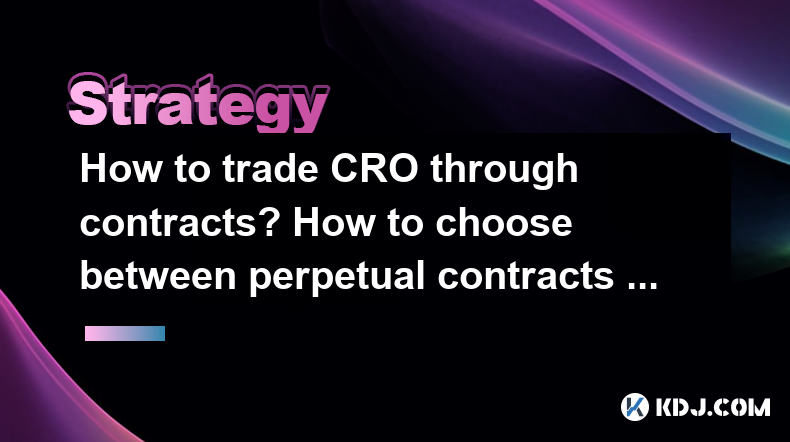-
 bitcoin
bitcoin $121833.232455 USD
-0.63% -
 ethereum
ethereum $4394.437030 USD
-2.00% -
 tether
tether $1.000570 USD
0.04% -
 bnb
bnb $1255.553465 USD
-3.73% -
 xrp
xrp $2.814944 USD
-1.59% -
 solana
solana $221.835346 USD
-2.40% -
 usd-coin
usd-coin $0.999869 USD
0.01% -
 dogecoin
dogecoin $0.249495 USD
-1.32% -
 tron
tron $0.336905 USD
-1.24% -
 cardano
cardano $0.816464 USD
-1.69% -
 chainlink
chainlink $22.130946 USD
-1.27% -
 hyperliquid
hyperliquid $44.208522 USD
-3.46% -
 ethena-usde
ethena-usde $1.000521 USD
0.02% -
 sui
sui $3.422897 USD
-2.51% -
 stellar
stellar $0.380164 USD
-1.31%
How to trade CRO through contracts? How to choose between perpetual contracts and delivery contracts?
Trading CRO via perpetual or delivery contracts offers diverse strategies; perpetuals allow indefinite holding, while deliveries have set expirations, each suiting different trading goals.
May 05, 2025 at 09:00 pm

Trading CRO (Crypto.com Coin) through contracts can be an exciting venture for those looking to diversify their cryptocurrency trading strategies. Contracts, specifically futures contracts, allow traders to speculate on the future price of CRO without needing to own the underlying asset. There are two main types of futures contracts: perpetual contracts and delivery contracts. Understanding the differences between these two and how to trade CRO using them is crucial for making informed trading decisions.
Understanding Perpetual Contracts
Perpetual contracts, also known as perpetual futures, are a type of futures contract that does not have an expiration date. This means that traders can hold their positions indefinitely, as long as they can maintain the required margin. Perpetual contracts are popular in the cryptocurrency market because they allow for high leverage and continuous trading.
Funding Rates: One unique feature of perpetual contracts is the funding rate mechanism. This rate is periodically paid between long and short positions to ensure that the perpetual contract's price stays close to the underlying asset's spot price. If the funding rate is positive, long position holders pay short position holders, and vice versa if the rate is negative.
Trading CRO with Perpetual Contracts: To trade CRO using perpetual contracts, follow these steps:
- Choose a Platform: Select a reputable exchange that offers CRO perpetual contracts, such as Binance or Bybit.
- Open an Account: Register and complete the necessary KYC (Know Your Customer) verification.
- Deposit Funds: Fund your account with the required cryptocurrency or fiat currency.
- Navigate to Futures Trading: Find the futures trading section on the platform and select CRO perpetual contracts.
- Place an Order: Decide whether you want to go long (buy) or short (sell) on CRO. Set your leverage, enter the amount you wish to trade, and place your order.
Understanding Delivery Contracts
Delivery contracts, also known as traditional futures contracts, have a set expiration date. At the expiration, the contract must be settled, either by physical delivery of the underlying asset or by cash settlement. Delivery contracts are less common in the cryptocurrency market but can still be used to trade CRO.
Expiration and Settlement: The key feature of delivery contracts is their expiration date. Traders must be aware of this date and decide whether to close their positions before expiration or settle the contract according to the terms.
Trading CRO with Delivery Contracts: To trade CRO using delivery contracts, follow these steps:
- Choose a Platform: Find an exchange that offers CRO delivery contracts. These might be less common, so you may need to look at specialized platforms.
- Open an Account: Register and complete the KYC verification process.
- Deposit Funds: Add the necessary funds to your account.
- Navigate to Futures Trading: Go to the futures trading section and select CRO delivery contracts.
- Place an Order: Decide on your position (long or short), set your leverage, enter the amount, and place your order. Remember to keep track of the expiration date.
Choosing Between Perpetual and Delivery Contracts
When deciding between perpetual and delivery contracts for trading CRO, several factors should be considered:
Trading Goals: If you are looking for continuous trading without worrying about expiration dates, perpetual contracts might be more suitable. If you prefer a more traditional approach with a clear end date, delivery contracts could be better.
Market Volatility: Perpetual contracts can be more sensitive to market volatility due to the funding rate mechanism. If you are comfortable with this, perpetual contracts might be preferable. Delivery contracts might be less volatile as they approach expiration.
Leverage and Margin: Perpetual contracts often offer higher leverage, which can amplify both gains and losses. Delivery contracts might have lower leverage but can still be used effectively with proper risk management.
Liquidity: Check the liquidity of both types of contracts on your chosen platform. Higher liquidity can lead to better price execution and lower slippage.
Risk Management in CRO Contract Trading
Effective risk management is crucial when trading CRO through contracts. Here are some strategies to consider:
Set Stop-Loss Orders: Use stop-loss orders to limit potential losses. For example, if you are long on CRO, set a stop-loss order below your entry price to automatically close your position if the price drops to that level.
Monitor Leverage: Be cautious with leverage. While it can increase potential profits, it also increases potential losses. Start with lower leverage until you are comfortable with the market dynamics.
Diversify: Do not put all your funds into one type of contract or one position. Diversify your trading across different assets and contract types to spread risk.
Stay Informed: Keep up with market news and developments that could affect CRO's price. This can help you make more informed trading decisions.
Practical Example of Trading CRO with Contracts
Let's walk through a practical example of trading CRO using a perpetual contract:
- Scenario: You believe that CRO's price will increase in the near future.
- Action: You decide to go long on CRO using a perpetual contract.
- Choose a Platform: You select Binance, which offers CRO perpetual contracts.
- Open an Account: You already have a verified account on Binance.
- Deposit Funds: You deposit USDT into your futures wallet.
- Navigate to Futures Trading: You go to the futures trading section and select CRO/USDT perpetual contract.
- Place an Order: You decide to use 10x leverage, enter an amount equivalent to $1000, and place a long order at the current market price.
- Monitor and Manage: You keep an eye on the funding rate and market conditions. You set a stop-loss order at 5% below your entry price to manage risk.
Frequently Asked Questions
Q1: Can I trade CRO contracts on any exchange?A1: Not all exchanges offer CRO contracts. You need to check specific platforms like Binance, Bybit, or other exchanges that list CRO futures to trade these contracts.
Q2: What happens if I hold a delivery contract until expiration?A2: If you hold a delivery contract until expiration, you will need to settle the contract according to the terms, which could be either physical delivery of CRO or cash settlement based on the final price of CRO at expiration.
Q3: How does the funding rate affect my perpetual contract position?A3: The funding rate in perpetual contracts is periodically paid between long and short positions to keep the contract price aligned with the spot price. If you are long and the funding rate is positive, you will pay the funding rate to short position holders. If the rate is negative, you will receive the funding rate from short position holders.
Q4: Is it possible to trade CRO contracts without leverage?A4: Yes, it is possible to trade CRO contracts without leverage by using a leverage of 1x. This means you are trading with your full margin and not borrowing additional funds from the exchange.
Disclaimer:info@kdj.com
The information provided is not trading advice. kdj.com does not assume any responsibility for any investments made based on the information provided in this article. Cryptocurrencies are highly volatile and it is highly recommended that you invest with caution after thorough research!
If you believe that the content used on this website infringes your copyright, please contact us immediately (info@kdj.com) and we will delete it promptly.
- Cardano (ADA), S&P Index, and Price Action: What's the Deal?
- 2025-10-10 16:25:16
- Unlock Free Crypto with Binance Learn & Earn Bitcoin Quizzes: A New Yorker's Guide
- 2025-10-10 16:45:13
- Central Banks Eyeing BTC and Gold: A New Era for Global Reserves?
- 2025-10-10 16:25:16
- Bitcoin Volatility & Seasonal Strength: What to Expect Now
- 2025-10-10 17:25:12
- Dogecoin's Price Drop: Are Whales Behind the Wheel?
- 2025-10-10 17:05:12
- XLM, Stellar Lumens, and the Institutional Boost: What's Driving the Surge?
- 2025-10-10 17:05:12
Related knowledge

Practical parameter settings for a Bitcoin multi-timeframe moving average system
Sep 18,2025 at 10:54pm
Optimizing Timeframe Combinations for Bitcoin Trading1. Selecting appropriate timeframes is crucial when building a multi-timeframe moving average sys...

How can I filter out false breakouts in Dogecoin high-frequency trading?
Sep 22,2025 at 01:00am
Understanding False Breakouts in Dogecoin Trading1. A false breakout occurs when Dogecoin's price appears to move beyond a defined support or resistan...

Techniques for identifying tops and bottoms in the Bitcoin on-chain NVT model
Sep 20,2025 at 07:54pm
Understanding the NVT Model in Bitcoin Analysis1. The Network Value to Transactions (NVT) ratio is often described as the 'P/E ratio' of the cryptocur...

What does the surge in open interest in Bitcoincoin futures mean?
Sep 20,2025 at 11:18pm
Understanding the Surge in Dogecoin Futures Open Interest1. A surge in open interest within Dogecoin futures indicates a growing number of active cont...

How can I use the Ethereum USDT premium to gauge market sentiment?
Sep 18,2025 at 11:55pm
Understanding the Ethereum USDT Premium1. The Ethereum USDT premium refers to the price difference between USDT (Tether) traded on Ethereum-based plat...

What should I do if Ethereum staking yields decline?
Sep 20,2025 at 06:18am
Understanding the Causes Behind Declining Ethereum Staking Yields1. The Ethereum network transitioned to a proof-of-stake consensus mechanism with the...

Practical parameter settings for a Bitcoin multi-timeframe moving average system
Sep 18,2025 at 10:54pm
Optimizing Timeframe Combinations for Bitcoin Trading1. Selecting appropriate timeframes is crucial when building a multi-timeframe moving average sys...

How can I filter out false breakouts in Dogecoin high-frequency trading?
Sep 22,2025 at 01:00am
Understanding False Breakouts in Dogecoin Trading1. A false breakout occurs when Dogecoin's price appears to move beyond a defined support or resistan...

Techniques for identifying tops and bottoms in the Bitcoin on-chain NVT model
Sep 20,2025 at 07:54pm
Understanding the NVT Model in Bitcoin Analysis1. The Network Value to Transactions (NVT) ratio is often described as the 'P/E ratio' of the cryptocur...

What does the surge in open interest in Bitcoincoin futures mean?
Sep 20,2025 at 11:18pm
Understanding the Surge in Dogecoin Futures Open Interest1. A surge in open interest within Dogecoin futures indicates a growing number of active cont...

How can I use the Ethereum USDT premium to gauge market sentiment?
Sep 18,2025 at 11:55pm
Understanding the Ethereum USDT Premium1. The Ethereum USDT premium refers to the price difference between USDT (Tether) traded on Ethereum-based plat...

What should I do if Ethereum staking yields decline?
Sep 20,2025 at 06:18am
Understanding the Causes Behind Declining Ethereum Staking Yields1. The Ethereum network transitioned to a proof-of-stake consensus mechanism with the...
See all articles

























![Web3 Crypto Market Morning Report: Fomo on the Bnb chain continues, Binance launches the chain-sweeping platform Meme Rush, the market value of Xiuxian exceeds 40 million U.S. dollars, OK Binance business war begins [Vic TALK Issue 1437] Web3 Crypto Market Morning Report: Fomo on the Bnb chain continues, Binance launches the chain-sweeping platform Meme Rush, the market value of Xiuxian exceeds 40 million U.S. dollars, OK Binance business war begins [Vic TALK Issue 1437]](/uploads/2025/10/10/cryptocurrencies-news/videos/web-crypto-market-morning-report-fomo-bnb-chain-continues-binance-launches-chainsweeping-platform-meme-rush-market-xiuxian-exceeds-dollars-binance-business-war-vic-talk-issue/68e861c5dbd1c_image_500_375.webp)
















































